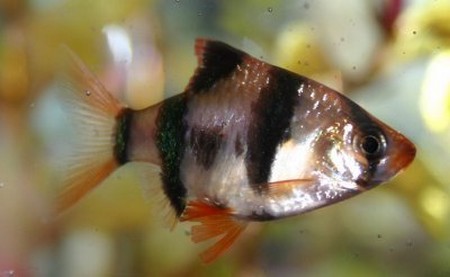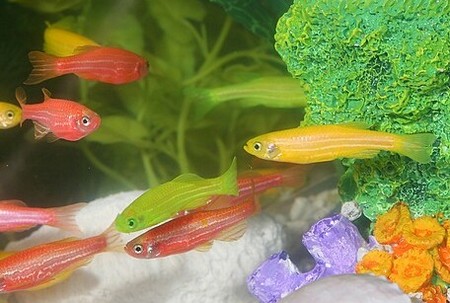The family Cyprinidae includes many popular egg-laying aquarium fish, originating from Asia and Africa. They include the barbs, danios, and rasboras, many of which are suitable for community aquaria. Breeding these fish in such a set-up is rarely successful, however, because they tend to eat their eggs; it is advisable to use a separate breeding tank instead.
Bars
These fish are generally very active and thrive in a small group, preferring an aquarium that is well stocked with plants. They live mainly in the mid-water and bottom levels of the tank. Many types have the characteristic whiskery barbels, the sensory organs that they use to help them find food at the bottom.
As well as the immensely popular rosy barb (Barbus conchonius), look out for the black ruby barb (B. nigrofasciatus), a slightly smaller species with smudgy black markings. When in spawning condition, you may notice that the red colour on the male’s head assumes a more purple hue.
Tiger barbs (B. tetrazona) must be kept in well-oxygenated water, otherwise they congregate at the surface, and hang there vertically. Although sociable and not overtly aggressive, these barbs may prove problematic if housed with fish that have long, trailing fins such as Siamese fighting fish (Betta splendens), because they tend to nip the fins of their companions.
Another common barb with similar markings is the five-banded barb (B. pentazona), although in this case the bands are less contrasting. The males are typically more brightly coloured than the females, and the red markings on their fins are also more distinct.
Spawning in the aquarium is reasonably straightforward. Breeding has produced a domesticated form with elongated fins which is sometimes available, but there are relatively few variants of barbs compared with livebearers. Sexing may be easier when the fish are in breeding condition, as in the case of the rosy barb, which becomes much brighter at this stage.
Daxios
Danios are relatively small, streamlined fish, with similar needs to those of barbs, although they tend to swim mostly in the upper water level, feeding at the surface. They are very sociable and should be kept in groups, especially when breeding. It is important to provide these fish with plenty of swimming space because they are naturally active.
Some forms are especially attractive, such as the popular zebra danio (Brachydanio rerio) with scintillating blue and metallic stripes along its body, and the well-named leopard danio (B.frankei), which is decorated with distinctive spots.
Sexing danios may be difficult, although males are usually more colourful. Zebra danios appear to develop strong pair-bonds, even in shoals, and are a good choice if you are inexperienced in trying to breed fish. With many danios, successful spawnings are relatively easy to accomplish, but you need to separate them from their eggs or they are likely to eat them.
Rasboras
In the wild, these fish are found in Southeast Asia, where there are approximately 30 species. Rasboras swim mostly in the middle and upper parts of the aquarium. They are best kept in a group; as well as showing them off to good effect, this also increases the likelihood of their forming natural pairs. This is important because it can be difficult to sex them, particularly outside the breeding season.
Many of these fish, such as the slender rasbora {Rasbora daniconius), are fairly subdued in colour, with a dark line running down either side of their otherwise silvery body. There are some striking exceptions, however: keep an eye out for the red-striped or glowlight rasbora (R. pauciperforata) – its pale green upper parts offset the distinctive red line that extends from nose to tail on both sides of its body. Even more colourful is the clown rasbora (R. kalachroma) -it is pinkish-orange overlaid with a violet iridescence, and has dark blotches on its sides.
Another attractive species is the harlequin rasbora (R. heteromorpha); this pale silvery-gold fish has a dark, triangular patch on each side of its body, tapering towards the tail, and noticeably prominent eyes. This type of rasbora may be fairly difficult to breed, and you need to include suitable plants in the aquarium on which it can deposit its eggs. Gnat larvae can be a good conditioner for rasboras, although other live foods can also benefit the fish in this way.
Other cyprinids
As well as the principal groups outlined here, several other cyprinids are also widely kept as aquarium fish. These include the red-tailed black shark (Labeo bicolor), which honours its more notorious but unrelated namesakes because of its streamlined shape and prominent, triangular dorsal fin. The striking red tail forms a vibrant contrast to its black body, making this lively fish an arresting spectacle. Unfortunately, these fish are aggressive towards others of their own kind, and breeding in an aquarium proves difficult. An easier choice is the related red-finned shark (L. erythrurus), which makes a rather more amenable tenant. It tends to be shy by nature, so make sure you provide it with adequate retreats such as rocks and suitable vegetation in the aquarium.

